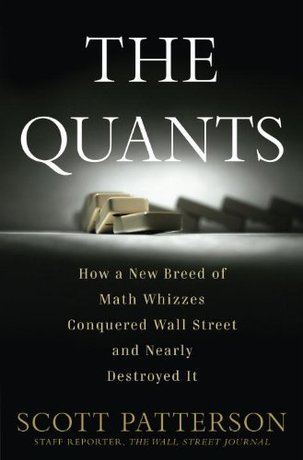The Quants

What it’s about
A wonderful introduction to the culture of quantitative trading on Wall Street, Scott Patterson’s, The Quants, takes a personal approach when chronicling events from the late 20th century up to and including the Global Financial Crisis of 2007-2009.
Focusing primarily on the narrative surrounding events involving and affecting notable quants such as Peter Muller, Ken Griffin, Cliff Asness, Boaz Weinstein, Jim Simons, Ed Thorp, and Aaron Brown, The Quants tells the story of the evolution of modern computational quantitative finance. While The Quants presents such an evolution from the perspectives of each of these iconoclasts, Patterson still retains an independent, third-person-omniscient point of view–importantly leaving the discussion of the factors leading to the Global Financial Crisis generally unbiased.
In contrast to what the book’s subtitle may suggest, The Quants is not largely an indictment of quantitative trading, though the concept of greedy (in Patterson’s mind) financial engineering in the forms of collateralized debt obligations (CDOs) and subprime mortgage backed securities (MBS) is a thesis presented at the end of the book. Nevertheless, Patterson’s first book on quantitative finance offers a relatively balanced, largely informative characterization of the modern leaders in finance without morphing into an accusatory slam of quantitative trading and analysis.
Topics, themes, and theses
Arbitrage, and all of its flavors, is an oft-occurring central theme in The Quants. Each quant Patterson chronicles specializes in his own trademark arbitrage strategy, as each quant is most familiar with a respective analytical process, trade, or financial security. For example, Boaz Weinstein is an expert in credit default swaps (CDS) and collateralized debt obligations (CDOs) while Jim Simons employs a high frequency approach that draws upon an arsenal of elite academic talent from fields as diverse as statistics, signal processing, and physics. Arbitrage is a core goal for each of these quants.
Though the general trades and arbitrage techniques particular to each quant are examined and thoroughly discussed, specifics and the nitty-gritty of the mathematics involved is left out of Patterson’s book (as expected). After all, individuals such as Jim Simons and Ken Griffin are extremely secretive–especially when it comes to how they make their billions–hence, one may only speculate on the specifics of their trades and analytical processes.
A key thesis in The Quants is that of irrationality and inefficiency seen in financial markets and the role quants play in such a dynamic. Patterson argues that, considering the violent crashes embodied by the Global Financial Crisis of 2007-2009 and the correspondingly vast gaps in liquidity that fueled such trouble, financial markets are thus irrational and inefficient.
Often, during times of crisis, the rational action for an individual actor is in contrast with the component action such an actor should take in the collective rational action of the market as a whole–it is possible for an individual to simultaneously act rationally on a personal scale while also contributing to the irrational behavior of the market as a whole. While Patterson does not explicitly cover this logical result, such reasoning is involved as Patterson asserts that irrationality played a central part in the abuse and misunderstanding of securitization and risk management that led to the occurrence of extreme financial losses. Additionally, when discussing the massive deleveraging that occurred throughout 2007 and 2008, Patterson alludes to the paradox of rationality that inevitably takes place when an individual firm realizes that it must deleverage in order to cut liquidity-risk, though the widespread deleveraging of the entire sector proves further damaging and dangerous for economic stability–the rational actions of individual firms can lead to irrational behavior on the scale of the entire financial system.
Bubbles, perhaps the result of hard-to-spot positive-feedback mechanisms, do occur, and the credit and housing bubbles undoubtedly led to the economic destruction embodied by the Global Financial Crisis and the Great Recession. The presence of veritable asset-price bubbles fueled by rampant positive-feedback loops is a valid counterexample in the argument against (a strong view of) the Efficient Market Hypothesis. Patterson frequently discusses bubbles both in the abstract and by cataloging violent price behavior, hence strengthening his argument that financial markets were, at times, inefficient during the time leading up to and including the Global Financial Crisis.
Finally, another of Patterson’s theses is the claim that the financial engineering and risk management practices in which quants engaged helped disembowel the financial system thus allowing the markets to tumble into collapse. The discussion of fat-tailed distributions, excessive leveraging practices, and the inclusion of alternative perspectives from those such as Benoit Mandelbrot and Nicholas Nassim Taleb all work to support Patterson’s thesis. This second thesis is well supported in that Patterson correctly comprehends that the true fault of the most recent financial crisis is not the quants’ alone. Yes, the activity of some irresponsible quants helped lead the financial markets to collapse, yet the issues at hand are far too complex to lay at the feet of quantitative analysts alone. After all, financial executives, and the clients to which they responded demanded that the industry push the envelop with respect to risk as unreasonable levels of reward were demanded. While quants may have engineered potentially globally detrimental financial products, they were only as such because of the clients’ and institutional investors’ disregard of unhealthy risk. For certain, quants played a role in the collapse of the financial system; however, such a role was merely a component of an ensemble cast of guilty parties.
Key characters
- Jim Simons (Renaissance Technologies), a hedge fund specializing in high-frequency strategies that employs a legion of PhDs from quantitative disciplines.
- Ken Griffin (Citadel), a large hedge fund conglomerate with a variety of investment strategies; Griffin got his start trading convertible bonds.
- Peter Muller (Process Driven Trading (PDT)), a hedge fund under the umbrella of Goldman Sachs focusing on statistical arbitrage techniques; Muller began his career at BARRA.
- Cliff Asness (Applied Quantitative Research (AQR)), a hedge fund implementing fundamental strategies such as those related to the work of Fama and French; Asness studied at Chicago under Eugene Fama before beginning his career at Goldman Sachs.
- Jim Thorp, the originator of the application of advanced quantitative strategies on Wall Street; Thorp wrote Beat the Dealer and Beat the Market and begun his investment career pricing warrants and trading convertible bonds. Thorp later ventured into statistical arbitrage.
- Boaz Weinstein, a specialist in credit derivatives including credit default swaps and collateralized debt obligations, Weinstein became a very valuable trader for Morgan Stanley and started his own fund, Saba, focusing on such trades.
Final thoughts
Scott Patterson’s The Quants is an excellent glimpse into the career trajectories of notable quantitatively orientated investors and traders such as Jim Simons, Cliff Asness, Peter Muller, Aaron Brown, Boaz Weinstein, Ed Thorp, and Ken Griffin. Its tone is enthusiastic, energetic, and unbiased, while its theses are (mostly) well supported by reason and anecdote, and its narrative is flawless.
I highly recommend The Quants to those who are curious about how the current leaders in quantitative finance came to power and the part they played in the Global Financial Crises of 2007-2009.
